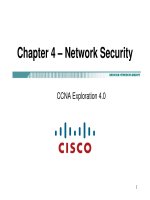Chapter+08+ ip+ security
Bạn đang xem bản rút gọn của tài liệu. Xem và tải ngay bản đầy đủ của tài liệu tại đây (1.07 MB, 32 trang )
Cryptography and Network Security
Chapter 8
IP Security
Lectured by
Nguyễn Đức Thái
Outline
IP Security Overview
IP Security Policy
Encapsulating Security Payload (ESP)
Combining Security Associations
Internet Key Exchange (IKE)
Cryptographic Suits
2
Key Points (1/2)
IP security (IPsec) is a capability that can be added to
either current version of the Internet Protocol (IPv4
or IPv6) by means of additional headers.
IPsec encompasses three functional areas:
• authentication,
• confidentiality, and
• key management.
3
Key Points (2/2)
Authentication makes use of the HMAC message
authentication code.
Authentication can be applied to the entire original
IP packet (tunnel mode) or to all of the packet
except for the IP header (transport mode).
Confidentiality is provided by an encryption format
known as encapsulating security payload. Both
tunnel and transport modes can be accommodated.
IKE defines a number of techniques for key
management.
4
IP Security Overview (1/2)
In 1994, the Internet Architecture Board (IAB) issued
a report titled “Security in the Internet Architecture”
(RFC 1636).
The report identified key areas for security
mechanisms.
Among these were the need to secure the network
infrastructure from unauthorized monitoring and
control of network traffic and the need to secure
end-user-to-end-user traffic using authentication and
encryption mechanisms
5
IP Security Overview (2/2)
To provide security, the IAB included authentication
and encryption as necessary security features in the
next-generation IP, which has been issued as IPv6
Fortunately, these security capabilities were
designed to be usable both with the current IPv4
and the future IPv6.
This means that vendors can begin offering these
features now, and many vendors now do have some
IPsec capability in their products.
The IPsec specification now exists as a set of
Internet standards.
6
Applications of IPsec
IPsec provides the capability to secure
communications across a LAN, across private and
public WANs, and across the Internet. Examples of
its use include:
• Secure branch office connectivity over the Internet.
• Secure remote access over the Internet
• Establishing extranet and intranet connectivity with
partners
• Enhancing electronic commerce security
7
An IP Security Scenario
8
Benefits of IPsec
In a firewall or router, it provides strong security that
can be applied to all traffic crossing the perimeter.
IPsec in a firewall is resistant to bypass if all traffic
from the outside must use IP and the firewall is the
only means of entrance from the Internet into the
organization.
IPsec is below the transport layer (TCP, UDP) and so
is transparent to applications.
IPsec can be transparent to end users.
IPsec can provide security for individual users
9
Routing Applications
IPsec can assure that
A router advertisement (a new router advertises its
presence) comes from an authorized router.
A neighbor advertisement (a router seeks to
establish or maintain a neighbor relationship with a
router in another routing domain) comes from an
authorized router.
A redirect message comes from the router to which
the initial IP packet was sent.
A routing update is not forged.
10
IPsec Documents
IPsec encompasses three functional areas:
• authentication,
• confidentiality, and
• key management
The totality of the IPsec specification is scattered
across dozens of RFCs and draft IETF documents,
making this the most complex and difficult to grasp
of all IETF specifications
11
IPsec Documents
The documents can be categorized into the
following groups
• Architecture
o RFC4301 Security Architecture for Internet Protocol
• Authentication Header (AH)
o RFC4302 IP Authentication Header
• Encapsulating Security Payload (ESP)
o RFC4303 IP Encapsulating Security Payload (ESP)
• Internet Key Exchange (IKE)
o RFC4306 Internet Key Exchange (IKEv2) Protocol
• Cryptographic algorithms
• Other
12
IPsec Services
IPsec provides security services at the IP layer by enabling a
system to select required security protocols, determine the
algorithm(s) to use for the service(s), and put in place any
cryptographic keys required to provide the requested
services.
RFC 4301 lists the following services:
•
•
•
•
•
•
Access control
Connectionless integrity
Data origin authentication
Rejection of replayed packets (a form of partial sequence integrity)
Confidentiality (encryption)
Limited traffic flow confidentiality
13
Transport Mode
Transport mode provides protection primarily for
upper-layer protocols.
That is, transport mode protection extends to the
payload of an IP packet.
Typically, transport mode is used for end-to-end
communication between two hosts (e.g., a client and
a server, or two workstations)
to encrypt & optionally authenticate IP data
• can do traffic analysis but is efficient
• good for ESP host-to-host traffic
14
Tunnel Mode
Tunnel mode provides protection to the entire IP packet.
To achieve this, after the AH or ESP fields are added to the IP
packet, the entire packet plus security fields is treated as the
payload of new outer IP packet with a new outer IP header
The entire original, inner, packet travels through a tunnel
from one point of an IP network to another; no routers along
the way are able to examine the inner IP header
• encrypts entire IP packet
• add new header for next hop
• no routers on way can examine inner IP header
• good for VPNs, gateway to gateway security
15
Transport and Tunnel Modes
16
Transport and Tunnel Modes Protocols
17
IP Security Policy
Fundamental to the operation of IPsec is the concept
of a security policy applied to each IP packet that
transits from a source to a destination.
IPsec policy is determined primarily by the
interaction of two databases,
• the security association database (SAD) and
• the security policy database (SPD)
Security Associations
Security Association Database
Security Policy Database
IP Traffic Processing
18
Security Associations (SA)
A key concept that appears in both the
authentication and confidentiality mechanisms for IP
is the security association (SA)
a one-way logical connection between sender &
receiver that affords security service to the traffic
carried on it
identified by 3 parameters:
• Security Parameters Index (SPI): A bit string assigned to this SA
and having local significance only
• IP Destination Address: address of the destination endpoint
• Security Protocol Identifier: indicates whether the association is
an AH or ESP security association
19
Security Association Database (SAD)
In each IPsec implementation, there is a nominal
Security Association Database that defines the
parameters associated with each SA.
•
•
•
•
•
•
•
•
•
Security Parameter Index
Sequence Number Counter
Sequence Counter Overflow
Anti-Replay Window
AH Information
ESP Information
Lifetime of this Security Association
IPsec Protocol Mode
Path MTU
20
Security Policy Database (SPD)
The means by which IP traffic is related to specific
SAs (or no SA in the case of traffic allowed to bypass
IPsec) is the nominal Security Policy Database
21
Security Policy Database
22
Encapsulating Security Payload (ESP)
ESP can be used to provide confidentiality, data
origin authentication, connectionless integrity,
an anti-replay service (a form of partial
sequence integrity), and (limited) traffic flow
confidentiality.
The set of services provided depends on options
selected at the time of Security Association (SA)
establishment and on the location of the
implementation in a network topology.
ESP can work with a variety of encryption and
authentication algorithms
23
Encryption and Authentication Algs
The Payload Data, Padding, Pad Length, and
Next Header fields are encrypted by the ESP
service.
If the algorithm used to encrypt the payload
requires cryptographic synchronization data,
such as an initialization vector (IV), then these
data may be carried explicitly at the beginning
of the Payload Data field.
If included, an IV is usually not encrypted,
although it is often referred to as being part of
the ciphertext.
24
Padding
The Padding field serves several purposes:
• to expand plaintext to required length
• to align pad length and next header fields
• to provide partial traffic flow confidentiality
25









